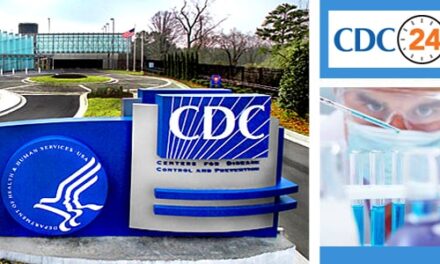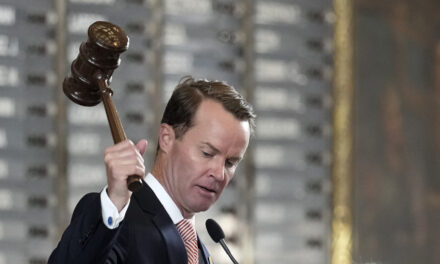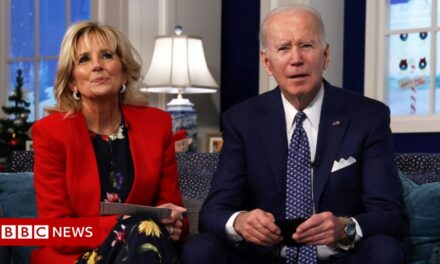
Barclays C.E.O. to Step Down After Jeffrey Epstein Inquiry

Image

The Biden administration will release the highly anticipated details of a federal vaccine mandate for private employers “in coming days,” a representative for the Department of Labor said Monday. When the details become public, a flurry of corporate vaccine mandates is expected to follow.
President Biden instructed the Department of Labor and its Occupational Safety and Health Administration in September to draft an emergency temporary standard requiring businesses with 100 or more employees to mandate vaccinations against the coronavirus or weekly testing. The process has been particularly painstaking given likely legal challenges to the rule.
The Office of Management and Budget completed its review of the rule on Monday, the Labor Department representative said. It will now go to the Federal Register for review, which will publish it “in the coming days,” the representative said.
The Department of Labor has received comments on the mandate from trade groups, including the Chamber of Commerce, as well as executives from companies like UPS, the Walt Disney Company, Fidelity Investments. Many companies have a long list of questions about how the requirement will work, including who will pay for testing associated with the mandate and how the federal government will track compliance.
Some companies, like 3M, Procter & Gamble, IBM, American Airlines, Alaska Airlines and JetBlue, have already moved forward with vaccine mandates, but others have said they are awaiting more details from the federal government.
Noam Scheiber contributed reporting.
Image
Barclays said on Monday that its chief executive, James E. Staley, would step down immediately following the results of an inquiry by British financial regulators into Mr. Staley’s relationship with the disgraced financier Jeffrey Epstein.
The surprise exit of Mr. Staley, 64, roiled the leadership of Barclays, a three-century-old lender that is one of Britain’s biggest banks. And it makes him the latest prominent figure to face blowback from his association with Mr. Epstein, a convicted sex offender who killed himself in 2019 after facing new allegations of sex trafficking of underage girls.
The bank said it learned on Friday of the preliminary conclusions of a nearly two-year investigation by the regulators, the Financial Conduct Authority and the Prudential Regulation Authority, into the two men’s relationship, which dates back to Mr. Staley’s tenure as the head of private banking at JPMorgan Chase. Mr. Staley used Mr. Epstein to connect with potential clients.
Barclays said in a statement that Mr. Staley agreed to step down as chief executive and from his position on the board, and that he intended to contest the investigation’s findings. It added that the investigation did not make any findings that Mr. Staley “saw, or was aware of, any of Mr. Epstein’s alleged crimes” and that it was “disappointed” with the outcome.
In an internal memorandum sent to Barclays employees on Monday, Mr. Staley alluded only to an investigation into the characterization of “a professional relationship I developed earlier in my career.” He added: “I do not want my personal response to those matters to be a distraction from the fantastic work you do every day to support our customers and clients.”
The Prudential Regulation Authority and the Financial Conduct Authority declined to provide any details about what their inquiry had found, saying in a joint statement that they “do not comment on ongoing investigations or regulatory proceedings.”
Barclays said the investigation focused on how Mr. Staley had characterized his relationship with Mr. Epstein to the board, and the subsequent description of the relationship in Barclays’s response to the Financial Conduct Authority.
Mr. Staley previously said that he had been “transparent and open” with Barclays about his ties to Mr. Epstein. His abrupt departure raises questions about why the board and regulators apparently came to different conclusions about the evidence presented in the investigation.
Last month, the office of the attorney general of the Virgin Islands asked Barclays for additional information about Mr. Staley’s ties to Mr. Epstein, as part of its lawsuit against the Epstein estate.
He will be succeeded as chief executive by C.S. Venkatakrishnan, Barclays’s co-president and head of global markets. In its statement, Barclays said that Mr. Venkatakrishnan became its “preferred candidate for this role over a year ago.”
Like Mr. Staley, he is a former JPMorgan executive. He first rose to fame for warning about the “London Whale” scandal that resulted in more than $6 billion in trading losses at the American banking giant. His elevation to co-president last year signaled to London’s finance community that he was a potential future leader of Barclays.
Mr. Venkatakrishnan will inherit Barclays at a crossroads. The bank said last month that its third-quarter profit more than doubled from a year ago, thanks to strong performance from its investment bank.
But the trading division saw its results drop as markets calmed down from the worst of the pandemic, making it harder to make money. And Barclays’s huge retail banking business faces stiff competition from new digital banks — including a new one from JPMorgan.
Shares in Barclays were down less than 1 percent in London trading on Monday. During Mr. Staley’s tenure, the bank’s shares lost about 10 percent of their value.
In February 2020, Barclays announced the regulators’ investigation, noting that Mr. Staley “developed a professional relationship with Mr. Epstein” earlier in his career. “Mr. Staley also confirmed to the board that he has had no contact whatsoever with Mr. Epstein at any time since taking up his role as Barclays Group C.E.O. in December 2015,” the company added. The board then recommended that Mr. Staley be reappointed as chief executive.
The board had previously stood by Mr. Staley in 2018 as New York authorities ordered the bank to pay $15 million in penalties after he tried to discover the identity of a whistle-blower who had questioned the hiring of a senior banker in 2016. The New York Department of Financial Services said it had found “shortcomings in governance, controls and corporate culture” at the bank.
In stepping down, Mr. Staley becomes the latest corporate leader to suffer consequences from being linked to Mr. Epstein. In January Leon D. Black announced his resignation as chairman and chief executive of Apollo Global Management after revelations that he had paid more than $150 million to Mr. Epstein.
Leslie H. Wexner stepped down as chief executive of L Brands, the parent company of Victoria’s Secret, after pressure over his ties to Mr. Epstein. And Bill Gates, the Microsoft co-founder, faced scrutiny after The New York Times reported in 2019 that he began a relationship with Mr. Epstein after Mr. Epstein had been convicted of sex crimes.
Even the British royal family has dealt with fallout from Mr. Epstein, with Prince Andrew giving up his public duties in 2019, after a disastrous interview with the BBC centered on his ties to the financier.
Mr. Staley, an American who is known as Jes, became chief executive at Barclays in 2015 after serving as a top executive at JPMorgan.
News of the investigation in 2020 prompted an activist hedge fund critical of Barclays to call for Mr. Staley’s dismissal. Sherborne Investors, which at the times described itself as the biggest single shareholder in Barclays, said in public letters that renominating Mr. Staley as a director was “extremely ill advised.”
But he was re-elected as director this year with nearly 98 percent of investors voting in his favor.
Image
American Airlines canceled more than 1,200 flights over the weekend, blaming bad weather and staffing shortages for the widespread disruption. The cancellations represented more than 12 percent of the airline’s scheduled flights for Saturday and Sunday, it said, and came just weeks after Southwest Airlines was forced to cancel nearly 2,000 flights.
Severe wind late last week hampered operations at Dallas-Fort Worth International Airport, American’s largest hub airport, cutting into runway capacity and forcing a round of cancellations, David Seymour, the airline’s chief operating officer, said in a note to staff on Saturday. That disruption, combined with bad weather elsewhere in its network, stranded American flight crews in the wrong places, hindering the airline as it went into a typically busy weekend.
“To make sure we are taking care of our customers and providing scheduling certainty for our crews, we have adjusted our operation for the last few days this month by proactively canceling some flights,” Mr. Seymour said. “We are taking this measure to minimize any inconvenience as much as possible. Most of the customers impacted by these changes are being rebooked the same day, and we apologize for having to make these changes.”
Airlines have struggled with brief, but significant disruptions since the spring as a travel resurgence collided with ambitious but tight flight schedules, bad weather and limited staffing after tens of thousands of workers took buyout or early retirement packages during the pandemic. Earlier this month, Southwest canceled hundreds of flights, also blaming bad weather that had similarly displaced its crews.
The travel recovery has come with “a lot of bumps in the operation,” Gary Kelly, Southwest’s chief executive, said on a call with investor analysts and reporters in October. “I would be the first to admit that things are messy,” he said.
American has faced similar challenges. But Mr. Seymour said in his note that the airline was confident that it was prepared for the busy holiday period, with nearly 1,800 flight attendants returning from pandemic leave on Monday and even more returning on Dec. 1. The airline is also hiring flight attendants, pilots and airplane maintenance technicians as it gets ready for an expected return to prepandemic levels of passenger travel next year.
Image
Coca-Cola closed a deal to acquire full ownership of the sports drink maker Bodyarmor for $5.6 billion, the company said Monday.
Coke had acquired a 15 percent ownership of Bodyarmor in 2018, with plans of acquiring the remaining 85 percent in the future. Bodyarmor, backed by Kobe Bryant in 2014, is a competitor to PepsiCo’s Gatorade and the Coke-owned Powerade, the two most popular sports drinks in the market.
Bodyarmor will be managed as a separate business within Coca-Cola’s North America operating unit. Mike Repole, a co-founder and the chairman of Bodyarmor, and his management team will continue to work with the brand under a separate agreement.
“Bodyarmor has been a great addition to the system lineup over the last three years,” said Alfredo Rivera, president of the North America operating unit of the Coca-Cola Company.
The sports drink market generated about $8.2 billion in sales in 2021 in the United States, a 15.2 percent jump from the previous year, according to Statista.
Bodyarmor is expected to generate $1.4 billion in retail sales, the statement said.
Image
Wednesday
-
F.O.M.C. meeting: Officials on the Federal Reserve’s Federal Open Market Committee are expected to announce that they will slow bond purchases, which they have been using to support the economy, and to give an up-to-date take on recent inflation and employment data. The Fed is not expected to raise interest rates until at least the middle of next year.
Thursday
-
B.O.E. meeting: The Bank of England is expected to announce that it will raise interest rates in 2022. Bank officials have been debating whether to raise interest rates as higher inflation and supply chain bottlenecks are forecast to last longer than they expected.
-
Uber earnings: The ride-hailing company is set to publish its financial performance report for the three months that ended in September. A decline in ridership during the pandemic has been somewhat offset by a surge in Uber’s food-delivery business, but analysts expect its mobility business to see some recovery during the quarter.
Friday
-
Jobs report: The Labor Department is expected to release its monthly jobs report for October. Economists expect job growth to have accelerated from September’s weak pace as hospitalizations and deaths linked to the coronavirus fell in October.
Image
Saudi Aramco, the world’s largest oil company, said Sunday that its profits for the third quarter nearly tripled compared with the period a year earlier, as demand for the fuel recovers from the pandemic and prices soar.
Aramco, Saudi Arabia’s national oil company, said that net income was $30.4 billion for the July-to-September period, up from $11.8 billion a year ago when demand for oil collapsed and prices tumbled.
The huge profits are largely a reflection of rapid increases in oil prices. Aramco’s statement did not give full financial details, but it is likely to have received about $70 a barrel on average in the quarter compared with $43.60 a barrel in the same period in 2020.
Saudi Arabia and other oil-producing countries cut output sharply in response to the fall in demand as the pandemic slowed driving, air travel and other activities. Now these countries are ramping up production but at a pace that is frustratingly slow in the view of some critics, including the Biden administration.
Aramco said that its crude oil output in the third quarter of 2021 averaged 9.5 million barrels a day, only a modest increase to the 9.2 million barrels a day in the same period in 2020.
In a statement, Amin H. Nasser, Aramco’s chief executive, said he was “optimistic that energy demand will remain healthy for the foreseeable future” despite headwinds like supply chain bottlenecks.
As world leaders gather in Glasgow this week for what is being described as a crucial United Nations climate summit, Aramco’s results are a reminder that the global economy is still hooked on oil. Many forecasters expect demand for oil next year to exceed 2019 prepandemic levels.
While Western oil companies like Royal Dutch Shell and BP are wary of new long-term investments in oil, a few companies, including Aramco and the Abu Dhabi National Oil Company, or ADNOC, are betting that there will be a market for their petroleum for many years to come.
Aramco said it increased capital expenditures by 19 percent in the quarter to $7.6 billion, in part to bolster the amount of oil it can produce to 13 million barrels a day from 12 million barrels a day.
The company, whose shares were listed on the local Tadawul exchange in 2019, will pay an $18.8 billion dividend for the quarter, mostly to the Saudi government.
Image
President Biden’s ambitious goals to wean the United States from fossil fuels could be upended by aging transformers and dated electrical lines that have made it hard for homeowners, local governments and businesses to use solar panels, batteries, electric cars, heat pumps and other devices that can help reduce greenhouse gas emissions.
The New York Times’s Ivan Penn reports that much of the equipment on the electric grid was built decades ago and needs to be upgraded. It was designed for a world in which electricity flowed in one direction — from the grid to people. Now, homes and businesses are increasingly supplying energy to the grid from their rooftop solar panels.
These problems have become more urgent because the fastest way to cut greenhouse gas emissions is to move machinery, cars and heating equipment that run on oil and natural gas to electricity generated by solar, wind, nuclear and other zero-emission energy sources. Yet the grid is far from having enough capacity to power all the things that can help address the effects of climate change, energy experts said.
Stocks edged higher on Monday, with the S&P 500 climbing 0.2 percent, while the Nasdaq composite was up 0.6 percent.
October was the S&P 500’s best month so far this year, with a 6.9 percent gain. Stocks rallied as investors shook off a number of concerns that had weighed on Wall Street in September.
Strong earnings are relieving concerns over headwinds from rising prices, labor shortages and supply chain constraints. With 244 companies in the S&P 500 having published their third-quarter financial performance reports as of Friday, 82 percent topped analysts’ expectations.
Investors will focus this week on the Federal Reserve’s policy meeting, where officials are expected to announce that they will slow bond purchases. The Labor Department will also release its monthly jobs report for October, updating investors on job growth and unemployment.
Source: https://www.nytimes.com/live/2021/11/01/business/news-business-stock-market

















